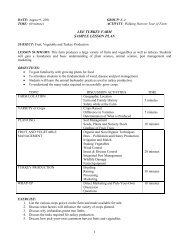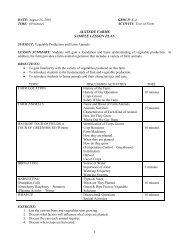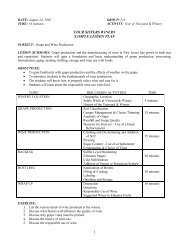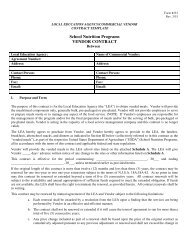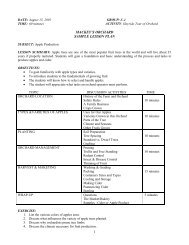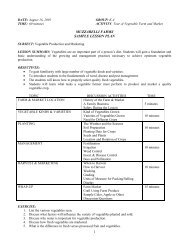Core Curriculum Content Standards - Agricultural Education
Core Curriculum Content Standards - Agricultural Education
Core Curriculum Content Standards - Agricultural Education
You also want an ePaper? Increase the reach of your titles
YUMPU automatically turns print PDFs into web optimized ePapers that Google loves.
Linking Students with AgricultureList of New Jersey Department of <strong>Education</strong> <strong>Core</strong> <strong>Curriculum</strong> <strong>Content</strong> <strong>Standards</strong>Which are Reinforced by an <strong>Agricultural</strong> <strong>Education</strong> Session atHeritage Station Market and Tree Fruit Farm,Richwood, New JerseyGrade Groups K-4Please note-- the first number is the instructional area, the second number is the New JerseyDepartment of <strong>Education</strong> <strong>Core</strong> <strong>Curriculum</strong> Standard and the third number after the colon (:) isthe Cumulative Progress Indicator that is also written out. The activity during the <strong>Agricultural</strong><strong>Education</strong>al Session is written in italic.1. Visual and Performing Arts(Grades K-4)1.5:2 Investigate, experience and participate in dance, music, theater and visual artsactivities representing various historical periods and world cultures. Students will viewand touch agricultural tools, tractors and specialized equipment.2. Health and Physical <strong>Education</strong>(Grades K-4)2.1:3 Identify and demonstrate responsible health behaviors for children. Students will washhands after petting and feeding animals.2.2:3 Discuss how family and friends are important throughout life and that relationshipsrequire respect for others. Students will visit a family agricultural enterprise and seethe market business in operation with members of the family providing labor.3. Language Arts Literacy(Grades K-4)3.2:3 Listen for a variety of purposes, such as enjoyment and obtaining information. Duringthe hayride students will receive agricultural information about growing fruits andvegetables produced on the farm.3.2:6 Develop listening strategies such as asking relevant questions, taking notes, andmaking predictions, to understand what is heard. During the hayride students will findanswers to questions about agriculture.3.3:3 Use writing to extend the experience. Students are encouraged to write follow upletters to the agricultural business.3.5:2 Demonstrate the ability to gain information from a variety of media. During thehayride information will be provided by narration.4. Mathematics(Grades K-4)4.3:7 Recognize the role of mathematics in their daily lives and in society. The retail markethas examples where mathematics is important to the agricultural business.4.5:4 Use a variety of tools to measure mathematical and physical object in the worldaround them. Students will see and use different measures that are used in the retailmarket.1
4.9:3 Recognize the need for uniform unit of measure. Students will see different sizebaskets and other measures used in the retail market and packing area.4.9:6 Understand and incorporate estimation and repeated measures in measurementactivities. Students will see different size baskets and other measures used in themarket and packing areas.5. Science(Grades K-4)5.1:2 Recognize that since the components of a system usually influence one another, asystem may not work if a component is missing. During the hayride students will seegrowing crops and the process of growing these crops will be explained and shown tothem.5.2:1 State a problem about the natural world in the form of a question. Experience withgrowing crops/animals will stimulate the development of problems that can then beresearched.5.3:2 Recognize that scientific ideas and knowledge have come from men and women of allcultures. Students will see that agriculture is concentrated food production and thecrops originated in different countries.5.4:2 Demonstrate how tools are used to do things better and more easily or to do tasks thatcould not otherwise be done. Students will see how agriculture equipment saves handlabor.5.4:4 Find and report on examples of how technology helps people. Students will see howagriculture equipment saves labor.5.5:1 Judge whether estimates, measurements, and computations of quantities arereasonable. Students will estimate the amounts in a variety of containers.5.5:2 Use a variety of measuring instruments, emphasizing appropriate units. Students willsee a variety of ways that agricultural products are sold.5.6:1 Compare and contrast living and nonliving things. Students will have the opportunityto see and experience plants and animals.5.6:2 Determine the basic needs of organisms. Students will have the opportunity to see andexperience plants and animals.5.6:4 Show that plants and animals are composed of different parts serving differentpurposes and working together for the well being of the organisms. Students will havethe opportunity to see and experience plants and animals.5.6:6 Group organisms according to the functions they serve in a food chain. Students willhave the opportunity to see and experience both plants and animals.5.7:1 Recognize the diversity of plants and animals on earth. Students will have theopportunity to see and experience many different trees, plants and animals.5.7:3 Recognize that individuals vary within every species. Students will have theopportunity to see and experience many different species of trees, plants and animals.5.7:4 Identify and describe external features of plants and animals that help them survive invaried habitats. Students will have the opportunity to see, to describe and to experienceliving plants and animals.5.12:1 Investigate the interdependence of living things and their environment. Students willsee how the environment is controlled to benefit of plants and animals.2
5.12:2 Explain how meeting human requirements affects the environment. Students willexperience how agriculture uses the environment to raise fish, fruits or plants for food.6. Social Studies(Grades K-4)6.1:4 Give examples of the impact of government policy on their lives. Students will see theimportance of the farm’s location to homes, roads and other businesses.6.4:2 Identify social institutions, such as family, religion, and government, that function tomeet individual and group needs. Students will see how a family business is operated.6.6:2 Describe the relationship of price to supply and demand. Students will have pricing ofagriculture products explained to them.6.6:5 Illustrate the balance between economic growth and environmental preservation.Students will see where this farm and market is located and its relationship topopulation.6.8:2 Discuss the similarities, differences, and interdependencies among rural, suburban, andurban communities. Students in traveling to the market and farm will see a variety ofcommunities.6.9:1 Explain the characteristics of renewable and nonrenewable resources and theirdistribution, and the role of resources in daily life. Students will see how growing acrop is a renewable resource.6.9:2 Explain how people depend on the physical environment and how they modify theenvironment. Students will see how the environment has been modified to maximizethe growth of plants, animals or fish.7. World Languages(Grades K-4)7.2:1 Demonstrate an awareness of culture. Students will see food is important to differentcultures and the celebration of holidays and special occasions.8. Cross <strong>Content</strong> Workplace Readiness(Grades K-4)8.1:5 Identify skills that are transferable from one occupation to another. Students will seethe many tasks performed at the farm and retail market.8.2:1 Understand how technological systems function. Students will see how technology isused in agriculture equipment.8.2:2 Select appropriate tools and technology for specific activities. Students will see howagricultural equipment is designed to perform specialized functions.8.5:3 Demonstrate principles of safe physical movement. Students will be required topractice safety and follow safety rules while visiting this agricultural enterprise.8.5:7 Identify and follow safety procedures for laboratory and other hands-on experiences.Students will be required to practice safety and follow safety rules while visiting thisagricultural enterprise.7/30/013



